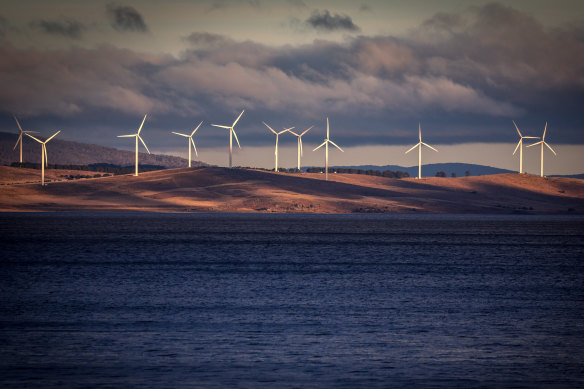By Nick Toscano
Electricity costs are climbing again across Australia’s eastern seaboard after a prolonged stretch of cold weather coincided with a wind power drought, forcing expensive gas-fired generators to meet peak demand.
In an update to be released on Wednesday, the Australian Energy Regulator reveals wholesale electricity prices – which retailers pay for power before supplying it to customers – rose sharply in every eastern state other than Queensland during the three months to June 30.

Australia’s transition to renewable energy is running behind schedule.Credit: Getty
The increases of up to 99 per cent in Victoria and 86 per cent in NSW were largely driven by greater power consumption from households dialling up their heaters, at the same time as low renewable energy generation, and network and generator outages were weighing on the system.
If higher wholesale prices are sustained, the increases risk flowing through to consumer bills when regulators reset each state’s yearly default price caps in May.
A separate update from the Australian Energy Market Operator (AEMO) on Wednesday will declare that total electricity demand in the grid was the highest on record for the June quarter.
“Colder weather has driven a new record for total electricity demand in the national electricity market for the June quarter,” AEMO chief executive Daniel Westerman said.
Coinciding with soaring demand, output from renewables slumped across the period. Wind turbines contributed just 12 per cent of generation, their lowest quarterly share since 2021, while lower-than-average rainfall reduced output from hydroelectric dams.
In response, gas-powered generation – a fast-ramping but expensive source of electricity – surged 70 per cent compared to the prior quarter, and was 16 per cent higher than the same time last year. Black coal usage also increased due to improved availability across Queensland’s coal power fleet.
Australian Energy Regulator board member Jarrod Ball said seasonal weather patterns and tight market conditions had contributed to the higher prices during the quarter.
“While we would expect to see wholesale prices rise as weather in southern states cools and demand rises to keep people warm, the combined impact of cold snaps, planned and unforeseen network outages, combined with rebidding and lower solar and wind output, has pushed electricity prices higher than this time last year,” he said.
Westerman said the market conditions underscored the key role that batteries, pumped hydro and flexible gas-powered generation would play as “renewable generation becomes more dominant”.
In its 25-year road map, released last month, AEMO determined the best and lowest-cost path for Australia’s energy transition was to develop a grid dominated by renewables, firmed up with battery and hydroelectricity storage, and backed up by gas-powered generation.
However, it warns new projects must be urgently accelerated as not enough are being built in time to compensate for the looming retirements of more coal-fired power stations.
A spokesperson for Energy Minister Chris Bowen said the data from AEMO and the regulator showed renewables were the cheapest sources of power. “When we’re forced to rely on coal generating, and ageing unreliable assets, it drives prices up,” the spokesperson said.
“The faster we can get more reliable renewables into the system, the better it will be for energy bills and energy reliability.”
The Business Briefing newsletter delivers major stories, exclusive coverage and expert opinion. Sign up to get it every weekday morning.